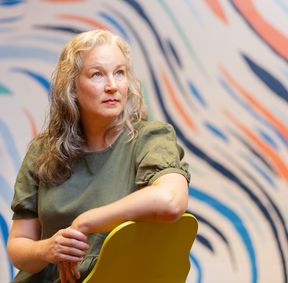Openings: Creativity helps us navigate the invisible

‘As a teacher and researcher in the visual arts, I find the invisible difficult, even frightening. Sensing for me is strongly tied to what I see, though there are many things we as humans cannot or do not want to see. Society and the global conversation function through words, and as a university we are tied to the spoken and written word. Visuality is a different way to observe the world, and my work is to ensure what is visual and seen is translated into words.
What we see can be vague and subject to interpretation. Even words are not always exact. As a university our job is to observe and interpret different perspectives. Researchers bring to light things we don’t see in everyday life, transforming findings from the microscope into words. From words we must advance to interacting with publics, making visible, conversational and understandable that which we create, innovate and give back to society.
That is one purpose of the Aalto’s radical creativity documentary. It’s a new communications medium and a way to appeal emotionally and visually, not just through words. Researchers have traditionally aimed for objective knowledge, but in a changing world we see that researchers are humans, too, with personalities, histories, in a place and time. There’s more there than just rational reasoning – could we make use of that in research? Emotional intelligence is an invisible resource that could be employed in teaching and research. In the arts, we use emotions and meanings as tools. Aalto University was founded to combine technology, business, science and art. I believe we can reach something new, creative and radical by bringing emotions into the mix.
In a turbulent and chaotic world, it’s hard to imagine new futures or realities. But there’s lots of potential in the invisible, and as we make choices, a direction and result emerges, becomes visible. This applies to making art and to the research process.
Doing or making with a low bar and at a fast pace is central to the idea of radical creativity. Iterative experimenting can dispel the invisible: when we enter the mode of active doing, it fosters hope. Experimentation inevitably leads to disappointments, which must be accepted and learned from, even amidst uncertainty.
At the university, we are constantly at the edge of the invisible. New knowledge is created by probing, interrogating, investigating this invisibility. Relating to the invisible and the unknown in new ways requires courage – and even silly or dumb ideas – and a beginner’s approach. Creativity requires letting go in order to birth something new.’
The author is Doctor of Arts and Head of Radical Creativity at Aalto University.
This article has been published in the Aalto University Magazine issue 33, September 2023.
Read more news

Research Council of Finland establishes a Center of Excellence in Quantum Materials
The Centre, called QMAT, creates new materials to power the quantum technology of coming decades.
Major funding powers development of next-generation machine technology aimed at productivity leap in export sectors
The BEST research project is developing new types of sealing, bearing, and damping technology.
The TAIMI project builds an equal working life – a six-year consortium project seeks solutions to recruitment and skill challenges
Artificial intelligence (AI) is changing skill requirements, the population is aging, and the labor shortage is deepening. Meanwhile, the potential of international experts often remains unused in Finland. These challenges in working life are addressed by the six-year TAIMI project funded by the Strategic Research Council, and implemented by a broad consortium.






